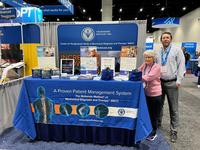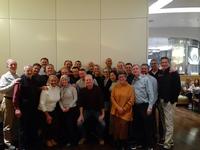News Room
McKenzie Method Drives 'Mechanical Care Everywhere' Mission
Physical therapy is about helping people. So, for Jason Ward, PT, Cert. MDT, blending his professional skills with missionary work came naturally.
For the past seven years, he's used physical therapy as charity in Peru, where he first visited along with a number of other medical professionals to provide care in underserved areas.
Many of his fellow missionaries – physicians, optometrists and pharmacists – came with plenty of equipment and instruments. With one fairly small box of exercise and education cards along with a resistance band or two, Ward seemed a little out of place at the temporary clinic.
"The prescription of movement and how to interpret symptoms was really what I was offering for patients to understand that you can do this yourself," Ward says.
His utilizing the McKenzie Method® of Mechanical Diagnosis and Therapy® (MDT) proved very successful with the rural population in the mountain village of Ccorca nonetheless. The simplicity and comparatively quick results of MDT make it rather ideal for the busy population of mostly farmers.
The experience inspired him to do a mission focused exclusively on physical therapy, a movement he calls "Mechanical Care Everywhere."
"I want to promote the method and expose what a simple mechanical exam can do for people wherever they are," says Ward, who hosts the popular "Mechanical Care Forum" podcast.
The MDT system begins with a thorough mechanical evaluation to establish a “cause-and-effect” relationship between historical pain behavior as well as the response to repeated test movements, positions and activities.
A systematic progression of applied mechanical forces utilizes pain responses and mechanical responses to classify the disorder. Clinicians then develop a specific plan of care based on those examination results that empowers patients to treat themselves when possible.
With no need for heavy equipment or power, Ward is able to take his mission to even the most remote locales. The rapid response to his treatment – sometimes immediate results – make it practical for a population that doesn't have ready access to physical therapy nor weeks and months before experiencing relief.
Men, women and even children spend long days planting, harvesting, tending to livestock and walking long distances, all of which lends itself to regular spine loading and oftentimes back pain.
"Some people walked hours to get to the clinic," says Lynn Grimm, PT, Dip. MDT, one of six who came on the pilot trip. "There was some acute trauma, some had fractures."
The clinicians spent two days in two locations in hopes of seeing the same patients twice. Diplomaed MDT practitioner Colin Davies began the week by offering an introductory presentation on the McKenzie Method to local physical therapists.
The first and third days of the four-day clinic were spent in Cusco, a city of about 500,000, and the second and fourth days were spent in Ccorca.
The clinic was certainly popular with a steady line that formed for assessment and intervention. Ward estimates his six clinicians treated about 14 to 20 patients per therapist a day.
"[MDT Founder] Robin McKenzie had always said that he wanted to reach as many people as possible and one of our tenants is self-care, so we thought this would be a good way to spread the word to people who don't have easy access to physical therapists," Grimm says.
And just as patients and local physical therapists became more knowledgeable, the clinicians had plenty to learn themselves.
"It reinforced my anticipation that this would be something that's very effective to at least provide some initial care," Ward says. "With the patient education, we found there are similar misconceptions and similar needs that our patients have in the States.
"In the same way, if we utilize a lot of what Robin McKenzie was telling his patients 45, 50 years ago, those people can be given a single sheet of paper just to teach them about cause and effect, mechanical versus chemical dominant pain, and “hurt” versus “harm” – all the things we're taught throughout MDT training," he adds. "The patient can be given information to explain that and use that long after we leave."
This next trip in August 2018 will include MDT clinicians from five countries. There were challenges in gauging some of the results from the pilot trip, although Ward has partnered with an experienced researcher to collect better data on the second trip.
Regardless, Ward knows it's working. One woman waited in line just to tell him that the work he did a year prior with the church mission had eliminated her pain.
She came only to say thank you because thanks to mechanical assessment and self-care, she did not need any treatment that day.
Share your news! Send your story to us and we'll post it for everyone to read.




